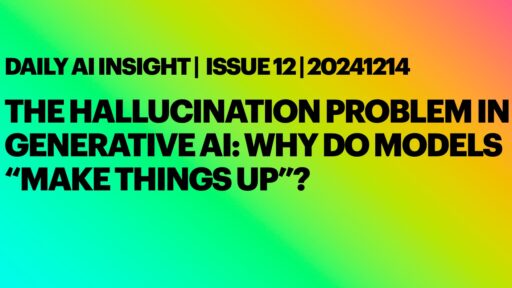What Is Hallucination in Generative AI? In generative AI, hallucination refers to instances where the model outputs false or misleading information that may sound credible at first glance. These outputs often result from the limitations of the AI itself and the data it was trained on. Common Examples of AI Hallucinations Fabricating facts: AI models might confidently state that “Leonardo da Vinci invented the internet,” mixing plausible context with outright falsehoods. Wrong Quote: "Can you provide me with a source for the quote: 'The universe is under no obligation to make sense to you'?" AI Output: "This quote is from Albert Einstein in his book The Theory of Relativity, published in 1921." This quote is actually from Neil deGrasse Tyson, not Einstein. The AI associates the quote with a famous physicist and makes up a book to sound convincing. Incorrect technical explanations: AI might produce an elegant but fundamentally flawed description of blockchain technology, misleading both novices and experts alike. Hallucination highlights the gap between how AI "understands" data and how humans process information. Why Do AI Models Hallucinate? The hallucination problem isn’t a mere bug—it stems from inherent technical limitations and design choices in generative AI systems. Biased and Noisy Training Data Generative AI relies on massive datasets to learn patterns and relationships. However, these datasets often contain: Biased information: Common errors or misinterpretations in the data propagate through the model. Incomplete data: Missing critical context or examples in the training corpus leads to incorrect generalizations. Cultural idiosyncrasies: Rare idiomatic expressions or language-specific nuances, like Chinese 成语, may be…
Secure by Design Part 1: STRIDE Threat Modeling Explained
Kubernetes Control Plane Components Explained
A 12 Factor Crash Course in Python: Build Clean, Scalable FastAPI Apps the Right Way
Golang Range Loop Reference - Why Your Loop Keeps Giving You the Same Pointer (and How to Fix It)
Terraform Associate Exam: A Powerful Guide about How to Prepare It
Terraform Meta Arguments Unlocked: Practical Patterns for Clean Infrastructure Code
A 12 Factor Crash Course in Python: Build Clean, Scalable FastAPI Apps the Right WayKubernetes Control Plane Components ExplainedSecure by Design Part 1: STRIDE Threat Modeling Explained
What Are Parameters? Why Are “Bigger” Models Often “Smarter”?
Install Azure-Cli on Mac
Overfitting! Unlocking the Last Key Concept in Supervised Machine Learning – Day 11, 12
Honored to Pass AI-102!
Instantly Remove Duplicate Photos With A Handy Script
Transformers Demystified - Day 2 - Unlocking the Genius of Self-Attention and AI's Greatest Breakthrough
Newest comment
